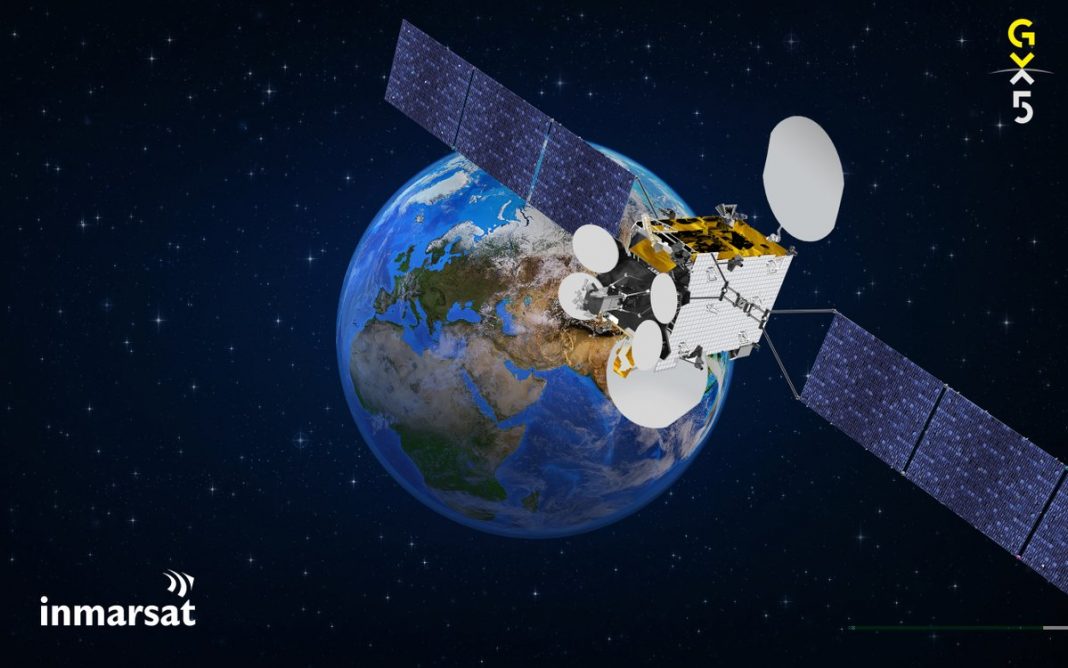Inmarsat’s newest and most advanced satellite to date has officially entered service this week. GX5 is Inmarsat’s next-generation satellite terminal, a Very High Throughput Satellite (VHTS), which will deliver approximately double the capacity of the four existing GX satellites combined.

GX5 is alive and kicking
Inmarsat Aviation has announced the commercial service introduction of its newest and most game-changing satellite to date. GX5, despite being smaller, more lightweight and faster to produce, is the first of Inmarsat’s next-generation satellites, delivering double the capacity of all four of the satellites previously supplying the Global Xpress (GX) network.
Philip Balaam, President of Inmarsat Aviation, commented on the addition of GX5, saying,
“GX Aviation and Jet ConneX are firmly established as the world’s leading inflight connectivity solutions and we have now embarked on a major, fully-funded development programme to ensure they remain at the very forefront of this industry.
“We are delighted to take the next step in this ambitious roadmap with GX5’s entry into commercial service. This is our most powerful satellite to date, delivering more capacity over Europe and the Middle East than the four existing GX satellites combined. In addition to transforming the quality of aviation connectivity today, it will ensure that our customers remain at the cutting-edge of technology innovation as their needs evolve and air traffic recovers in 2021 and beyond.”
The successful implementation of GX5 is the start of a huge campaign by Inmarsat to significantly improve the coverage and capacity of the GX network. Over the next two years, four more satellites will launch, and by 2024 three more will be added.

Inmarsat’s GX customers include Lufthansa, Qatar Airways, Air New Zealand, Singapore Airlines, AirAsia and Virgin Atlantic.
A year since launch
GX5 was launched successfully from the Guiana Space Centre in Kourou, French Guiana on 26 November 2019. However, satellite launches are only the start of bringing a new vessel like this into service.
The satellite has been migrating to its final orbital slot since last November. It was confirmed to have reached 11E in geostationary orbit on August 17th this year. It is now happily settled at 35,786 km / 22,236 miles above Earth, providing significant extra capacity over Europe and the Middle East.
GX5 will provide a capacity that is approximately double that of the entire GX fleet of four satellites (GX1 to 4). In tandem with its expanded ground station network and cloud-based processing, the new addition will significantly boost the capabilities of the GX network for airline passengers, as well as for maritime and government services.

The new ground stations for GX5 are:
- Aussaguel, France: This is a new GX site and Inmarsat’s first Ka-band antenna at this location.
- Burum, Netherlands: This will be the first Ka-band gateway hosted at Burum. It has been an Inmarsat site for many years.
- Cheia, Romania: A new site, Inmarsat’s first Ka-band antenna at this location.
- Fucino, Italy: This will be the second Inmarsat Ka-band gateway at the Fucino site.
- Kofinou, Cyprus: This is a new site for Inmarsat.
- Nemea, Greece: This is the third Inmarsat gateway in Nemea.
Next – GX6A and 6B
While celebrating the service entry of its most powerful satellite to date, Inmarsat is also making preparations for the launch of its next additions to the network. GX6A and GX6B are slated for launch in 2021.

This pair of payloads are designed to prepare the network for the coming 5G era. They will host advanced Ka-band payloads, giving depth to the GX network and providing capacity boosts as and when needed in bespoke locations around the world.
Following these. GX10A and 10B will be the first Inmarsat satellites to be deployed into highly elliptical orbit (HEO) to provide coverage in the most remote places on Earth. Dedicated to the Arctic region, these satellites will launch in 2022.
This article is brought to you by Simple Flying Connectivity, a new category on Simple Flying dedicated to inflight connectivity. Click here to read all of our inflight connectivity content.
[ad_2]
Source link



